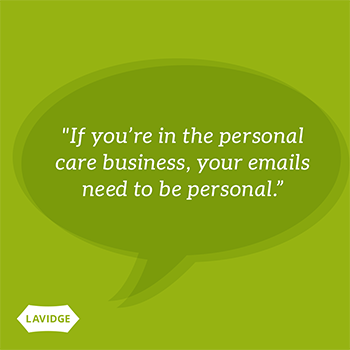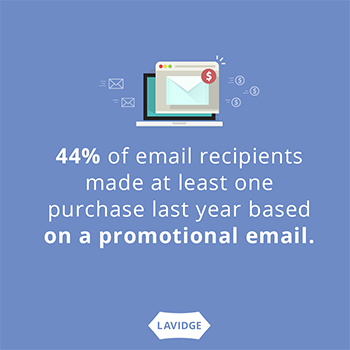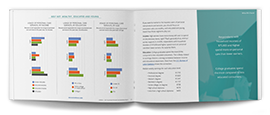Sign up for our LAVY email
and get our bi-monthly newsletter.
We complain when email piles up in our inbox, but we can’t get enough of it.
There is compelling evidence that email marketing works—77% of consumers prefer to receive permission-based marketing communications through email.1 But retail service businesses often struggle getting their emails read and generating meaningful action. According to MailChimp, only 18.4% of consumers open email from retail service companies, with a click-through rate of just 1.96%.
Even though most people believe they receive too many advertising emails, retail service businesses can break through the clutter with a smart marketing strategy, relevant content and thoughtful design. This is especially true for retail services. It's an industry which mostly addresses services people can do without—wants, not needs. Salons and fitness club memberships can be perceived as luxuries when rent is due.
To combat the inherent discretionary nature of retail services, email can be used to position the industry as a wellness provider. For example, great email content can underscore the importance of spending money on yourself because it will make you more confident. You’ll feel better. Retail services can affect how people perceive you, and that can lead to career advancement and higher salary. This content strategy gives consumers permission to spend money on retail products and services or renew their franchise memberships, even when money is tight. An excellent email can make your retail services seem necessary, even compulsory.
An excellent, compelling email is an effective tool to talk with customers who actually want to hear from you. Most retail service businesses don’t market one-time products; they offer services that are recurring, such as hair styling, manicures and massages. Some offer monthly memberships or loyalty programs which reward them for joining. Emails provide gentle reminders to return. You don’t need to say, “It’s time for your haircut.” Soft email marketing campaigns such as sending an email about the latest social influencer or celebrity hair styles will do the trick just as well, and in a manner customers appreciate. It also opens doors for cross-channel marketing between your email and social strategies.
Additionally, if you’re in the retail services industry, your emails will perform best when personalized. Data-driven marketing allows you to communicate with people the way you would talk to a friend. Providing them with seasonal-related information without specific “salesy” offers can help you form genuine and lasting bonds. Calling them by name and tailoring messages for important life events such as a birthday or anniversary helps immensely, too.
 Not all customers are alike
Not all customers are alikeIn order to be effective, an email’s content must be closely matched to the recipient. You’d talk differently to a new customer than to someone who’s visited your business a dozen times, right? If you’re approaching potential customers via a rented or opted-in list, you’ll be speaking with people who haven’t yet interacted with your brand. They know nothing about you, so they’ll need a delicate touch. Customers who have visited you only once should receive encouragement that they made the right decision. On the other hand, longtime customers are looking for more value and continued reasons to patronize you.
New customers don’t want to be sold, so initial emails should purposely avoid anything that smells of sales. If a customer had their first massage, send them an email reminding them to drink water. A first-time visitor to your hair salon might appreciate an email with tips about keeping that just-styled look.
This is how relationships are nurtured. Your goal is to be seen as a resource, expert and friend.
We delete and unsubscribe from emails when they’re not perceived as valuable. That starts with the subject line and preview text, which can add value and context to the contents of the email. There’s an art to these elements; each has specific recommended character limits. The sender, the subject line and preview text work together to create something compelling. Using a copywriter with digital marketing experience who knows how to finesse these elements can boost your open rate.
Look no further than how you handle your own inbox. When a new email arrives, you quickly scan these elements while a finger hovers over the delete key. If the email teasers aren’t personalized, specific and valuable, you’ll send it packing.
Offers have long been the domain of emails. Coupons, limited offers and gift giving are typical ingredients. While it’s true people often look for monetary value in marketing messages, they really want content that is pertinent to them. Useful information that can make their lives better will be appreciated.
Many mid-sized businesses struggle with this. Desiring traffic and money in the till, they’ll send emails with all-cap messages: LIMITED TIME, 2-FOR-1, COUPON EXPIRING SOON. But those don’t foster or deepen relationships.

Let’s return to the emails you receive. The companies that send you frequent and valuable information are also the businesses you’re likely to patronize on a regular basis.
Optimal customer retention is what it’s all about. It’s a cliché to say that it’s cheaper to keep a customer than to find a new one, but it’s true. The longer you keep the customer, the greater the return. Longtime customers spend more money with you, cost less to service and make more referrals.
Email marketing can often do more harm than good. Make sure your emails are appropriate to the specific customer stage, provide valuable and engaging content, and soft-sell any offers.
Unlike some other industries, emails from a retail services business should provide an easy way for customers to make an appointment. If you’re reading an email after work or during the evening, you’ll have to wait until the next morning to schedule an appointment—that is, if you remember. There’s a good chance you won’t follow through.
To overcome this lost opportunity, consider location-based marketing which offers an easy scheduling mechanism. There are a number of first-rate and inexpensive online scheduling or “request an appointment” tools you can add to emails. This would be an excellent pairing to a killer email strategy and would take advantage of an action motivated by evocative content.
A quick scan of the data featured in the accompanying sidebar, “Unsubscribe Me,” makes clear the challenges of email marketing, but it also presents tremendous opportunities. Perhaps unsurprisingly, the survey reports that more than 25% of us unsubscribe from emails because we get too many of them.
Just about every item in the list can be overcome, and each provides a compelling message about what not to do. The belief that “emails are always trying to sell me something” is strong justification for what we already know: present valuable content that will position you as an expert, not a sales clerk. And “getting too many emails from this company specifically” is a good reminder to avoid the temptation to bother customers every week. Instead, send helpful messages at less intrusive intervals such only once a month, or less.
LAVIDGE, an Arizona franchise marketing agency can make your email campaigns more effective and user-friendly through personalization.
To learn more, give us a call at 480.998.2600 or send email to info@lavidge.com.
Reasons that U.S. Internet users unsubscribe from email lists.
26% I get too many emails in general
21% The emails are not relevant to me
19% I receive too many emails from this company specifically
19% The emails are always trying to sell me something
17% The content of the emails is boring, repetitive and not interesting to me
16% I don’t have time to read the emails
13% I receive the same ads and promotions in the email that I get in print form (direct mail, print magazines, newspapers, etc.)
11% The email is too focused on the company’s needs, and not enough on my needs
10% The email seems like it is intended to meet other people’s needs, not people like me
10% The emails look too cluttered and sloppy
10% I don’t trust their email to provide the information I need to make purchase decisions
7% I get emails that don’t look good on my smartphone

This article is a brief abstract of our exclusive and authoritative study that takes the guesswork out of advertising and marketing retail services. Rather than speculating about what will drive consumers to action, we've asked them.
Sign up for our LAVY email
and get our bi-monthly newsletter.